Moru Curry, also known as Pulissery, is a traditional South Indian dish made with whisked curd (yogurt), coconut paste, and tempered spices, creating a mildly spiced, tangy curry. This comforting dish is a staple in Kerala cuisine and is typically served with steamed rice. Beautifully simple and packed with flavor, this Kerala Moru Curry recipe is sure to become a favorite in your family’s dinner rotation.
About Moru Curry
Here I share my mom’s Moru Curry recipe, a traditional dish from the South Indian cuisine. This deliciously spiced and seasoned yogurt curry is a longtime family favorite.
A Kerala style curry, Moru is a yogurt based curry that can be made either with or without coconut. The word “Moru” refers to “buttermilk” in Malayalam. My mom’s recipe actually calls for curd or yogurt instead of buttermilk.
Sour curd is whisked in water to get a buttermilk like consistency. Moru curry can also be made with traditional buttermilk acquired from churning butter. Both ways the curry tastes just like the authentic dish I grew up with.
Also known as Nadan Moru Curry, Moru Charu, Kachiya Moru or Pulissery, Moru Curry is a part of the Onam Sadya.
Spiced with green chilies for heat, cumin for perfumed warmth and ground coconut, this delicious dish is perfect on a hot summer’s day. No matter what you call it, this meal is sure to please.
Why This Recipe Works
My mom’s recipe uses ground coconut, green chilies and cumin paste, all of which bring a great deal of flavor to the curry. It can be made without adding the coconut paste depending on your flavor preferences, too.
While many of you are familiar with my cooking, I learned from the very best – my mom. This recipe is her version of Moru Curry, and it is delicious.
If you are wanting to make this Keralan specialty at home, I highly suggest you try this delightful and simple pulissery recipe.
While sometimes this dish is simply served over rice, I sometimes choose to add in a whole host of vegetables to turn it into a full-on meal.
If you love veggies as much as I do, I suggest trying my recipe with my favorites for this curry: taro root, ash gourd, yam and malabar cucumber (yellow cucumber or vellarikka).
If you opt to serve it as a plain pulissery without veggies, don’t worry. It is jam-packed with flavor and will be sure to tantalize your tastebuds all the same. Happy eating!
How should I prepare the vegetables for this curry
My personal favorite vegetables to add to Moru Curry or pulissery are taro root (a.k.a. arbi), ash gourd, yam and malabar cucumber. Follow the instructions below to make these vegetables the most flavorful:
- Taro root (arbi, chembu): Peel and steam or cook taro roots in pan. Then lightly fry or sauté in coconut oil. Add to the buttermilk mixture.
- Ash gourd (kumbalanga): Peel, chop, boil or steam. Drain, add to the curd and coconut paste mixture.
- Yam: Peel, chop, steam or boil. Strain the water. Add steamed yam to the buttermilk mixture.
- Malabar cucumber (vellarikka): Peel, remove the seeds, chop and cook in water until tender. Drain the water and add to the curd mixture.
- Greens: Spinach, amaranth and drumstick leaves are some healthy options. You can either sauté the chopped leaves in coconut oil, until they wilt and add to the yogurt mixture. Or you can blanch, mash and then use in the pulissery recipe.
Step-by-Step Guide
How to Make Moru Curry
To make my mom’s Moru Curry recipe, there are five steps you’ll need to complete. First, make your coconut paste.
1. Make Coconut Paste
1. Add ½ cup grated fresh coconut, 1 teaspoon chopped green chilies (equivalent to 2 to 3 chilies) and 1 teaspoon cumin seeds in a spice grinder or blender.
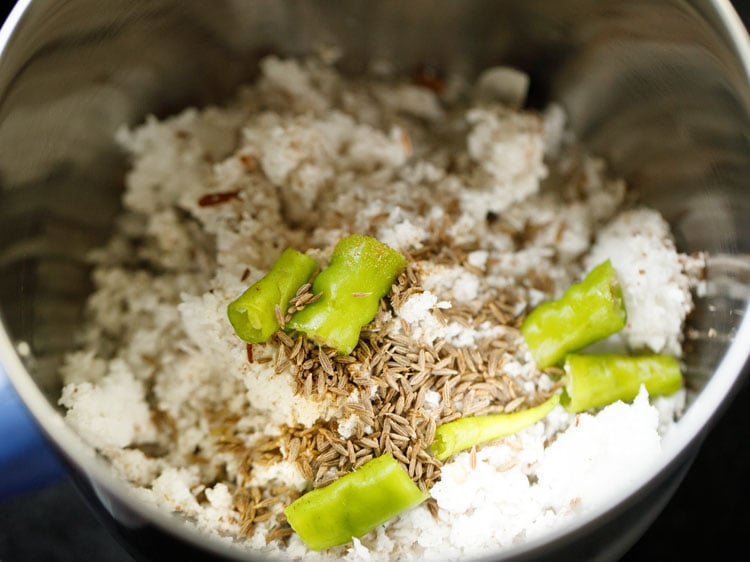
2. Add 4 to 5 tablespoons water and grind to smooth paste. Set aside.
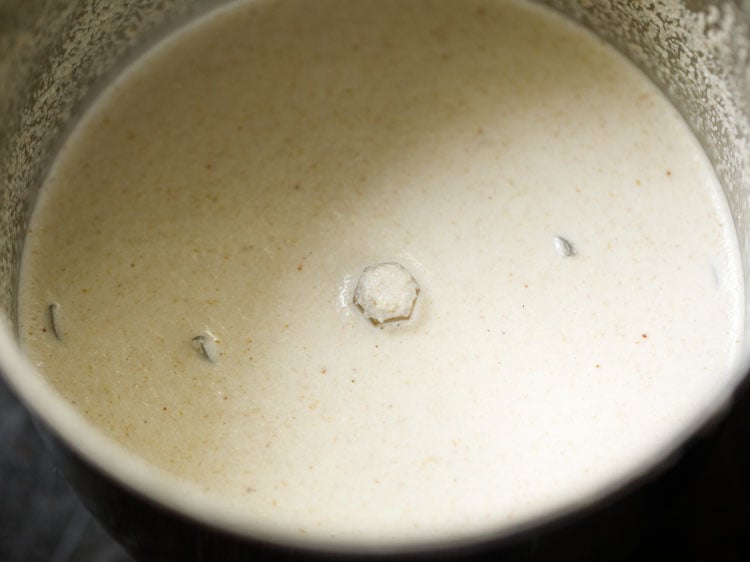
2. Make Buttermilk Mixture
Now you are ready to move on to step 2, making the buttermilk mixture.
1. In a saucepan or pot, add 1 cup sour curd (yogurt).
Tip: If your curd (or yogurt) isn’t sour tasting, keep it at room temperature for 2 to 4 hours until the taste becomes sour. The curd should be sour and not rancid or spoiled. You should be able to smell the difference, with good curd smelling a bit sour and astringent.
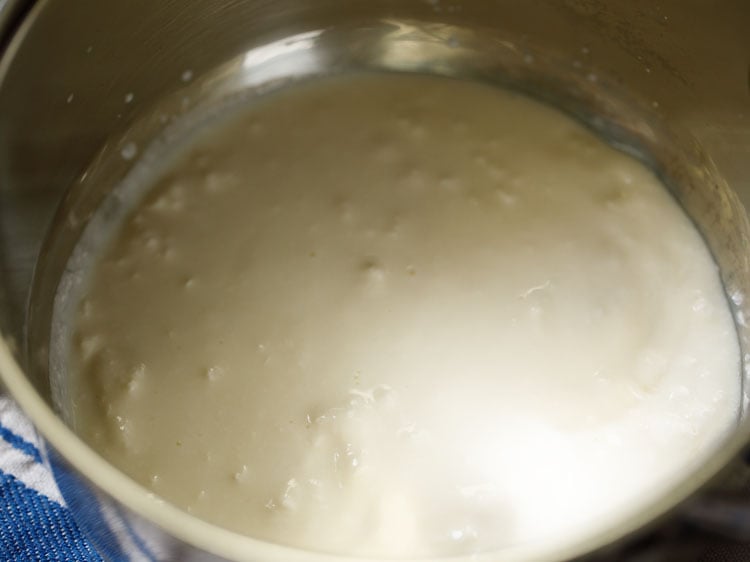
2. Add 1 cup water and ¼ teaspoon turmeric powder. If you added more water to your coconut paste, then add less water at this step.
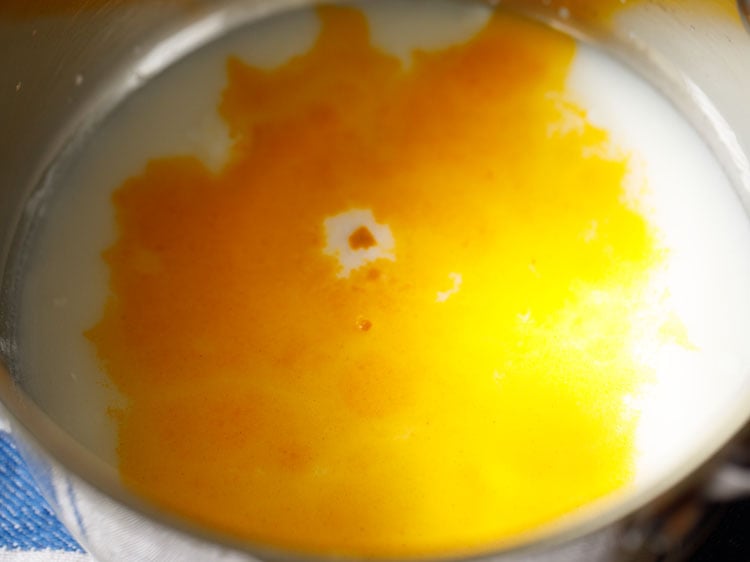
3. Whisk to a smooth buttermilk consistency.
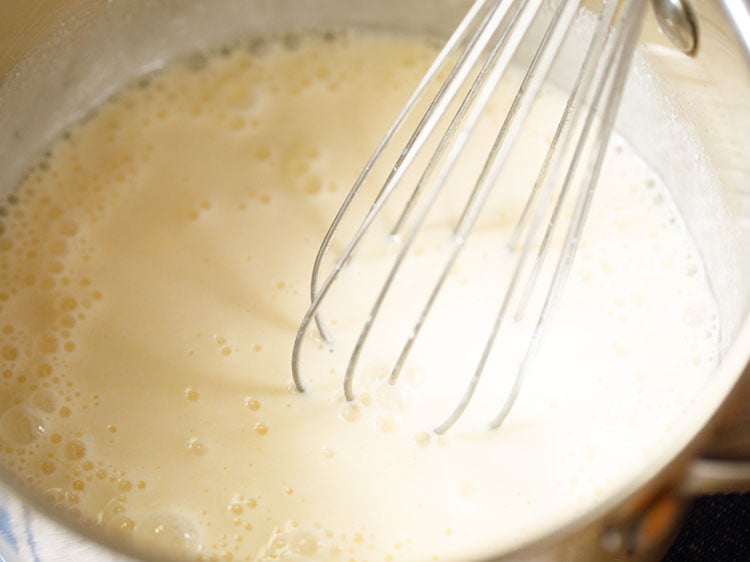
4. Add the ground coconut paste from step 1.
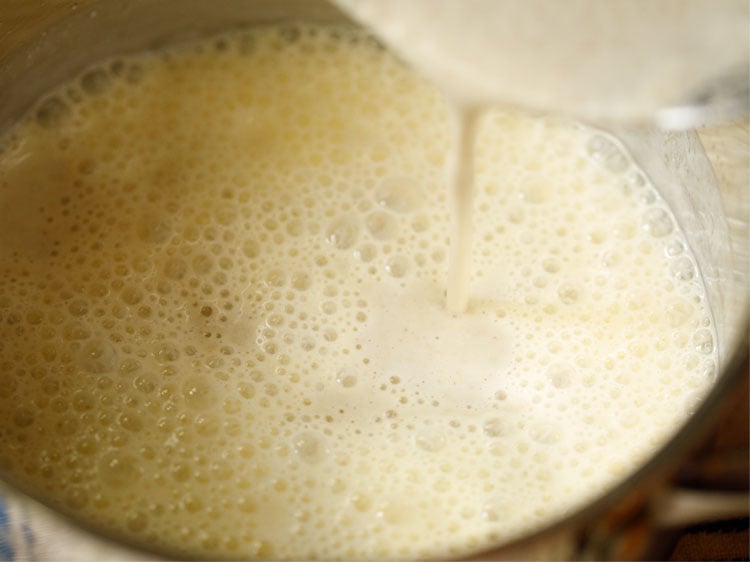
5. Add salt as needed.
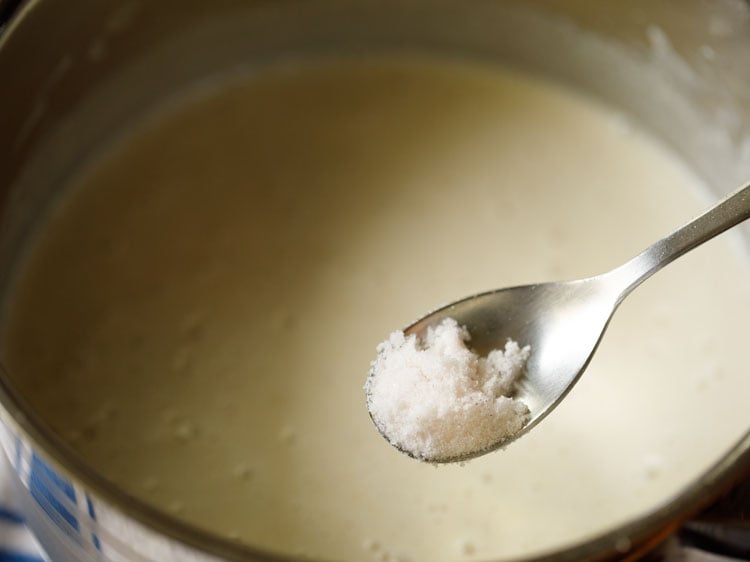
6. Mix buttermilk with paste and salt until well combined.
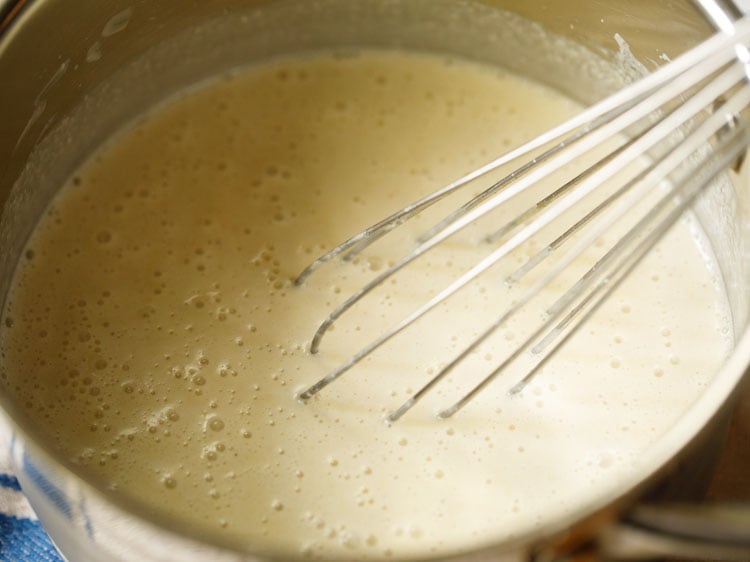
3. Simmer Curry
1. Place the saucepan filled with the buttermilk-coconut mixture on the stovetop over low heat.
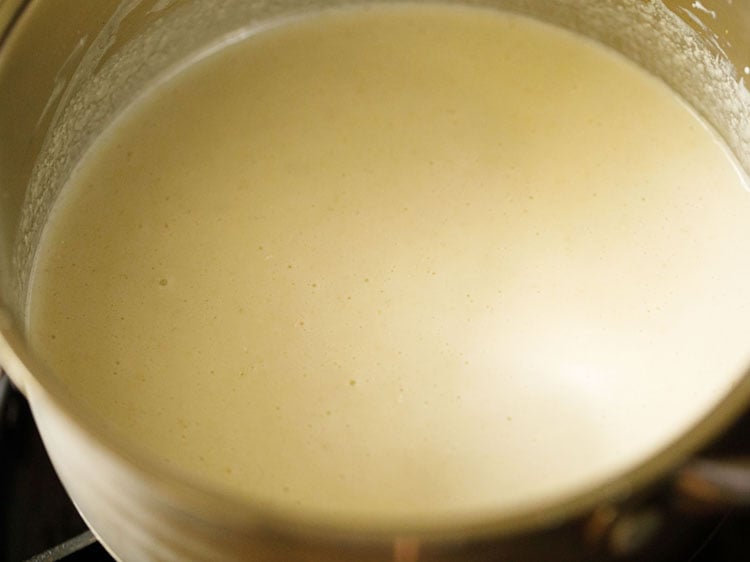
2. Whisk occasionally, every 2 to 3 minutes.
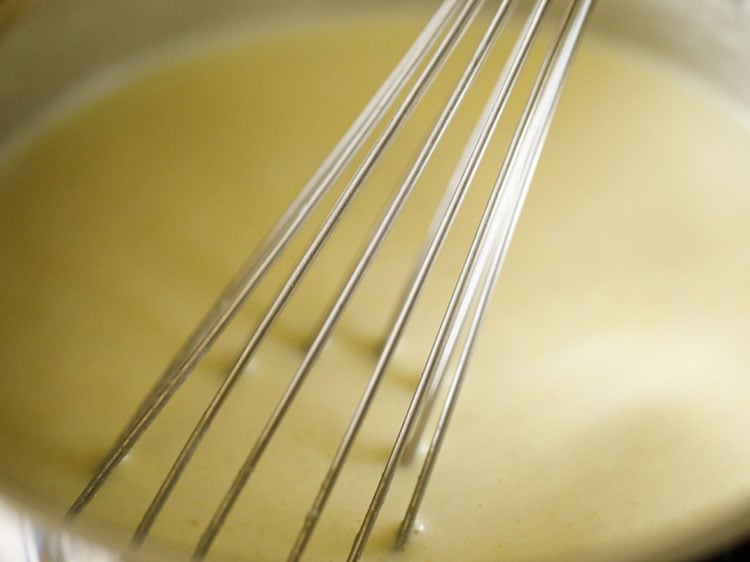
3. Let the mixture become hot, but do not allow it to come to a boil. When you see steam coming from the mixture, remove it from the heat.
Cover and set aside. Boiling can curdle this delicate yogurt curry.
Additionally keep in mind that the curry thickens on cooling. So you could keep the consistency slightly runny if you plan to reheat the curry for lunch or dinner.
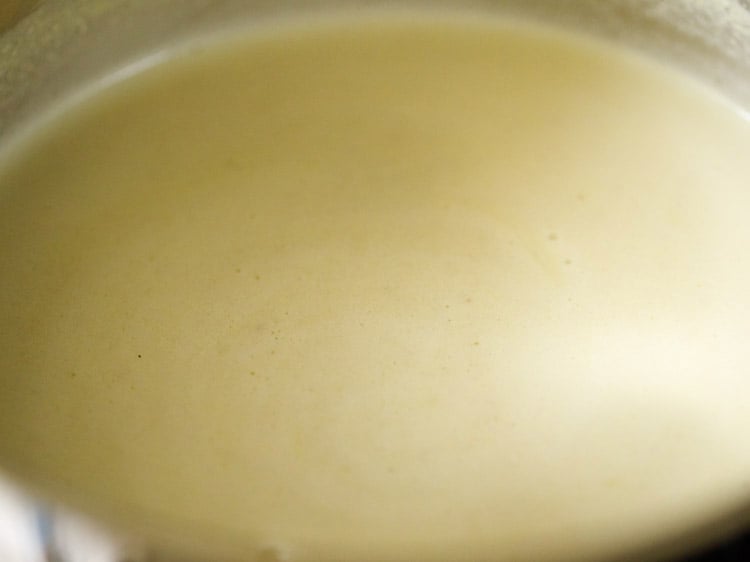
4. Temper Spices
You are now ready to move on to step 3, tempering the spices.
Tempering is a vital step in Indian cooking. Unlike the term as it is known in America (which specifically refers to chocolate), tempering is all about extracting maximum flavor from spices.
To properly temper your spices for this Moru Curry recipe, I recommend using coconut oil. This will offer the most traditional and authentic flavor to the dish.
1. Heat 2 tablespoons coconut oil in a small pan over medium heat. Add ½ teaspoon mustard seeds.
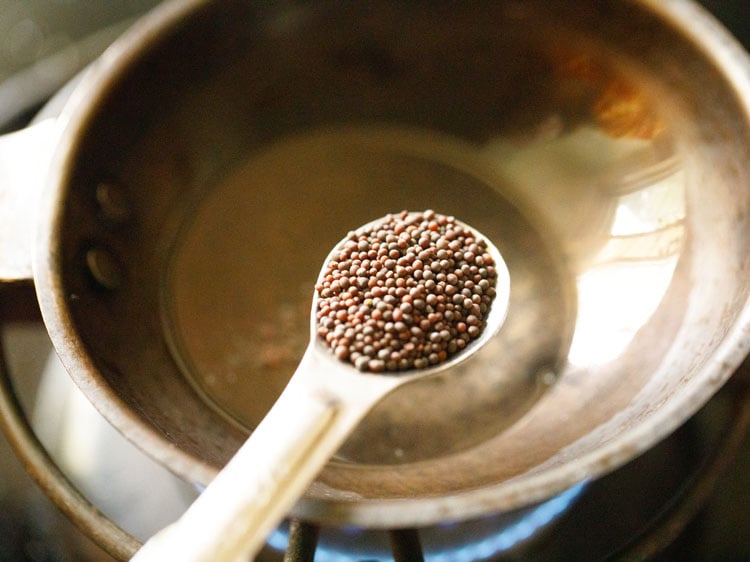
2. Let mustard seeds crackle. This is the magical part of tempering aka tadka! All of the spices in the oil are awakening when you hear that crackly sound.
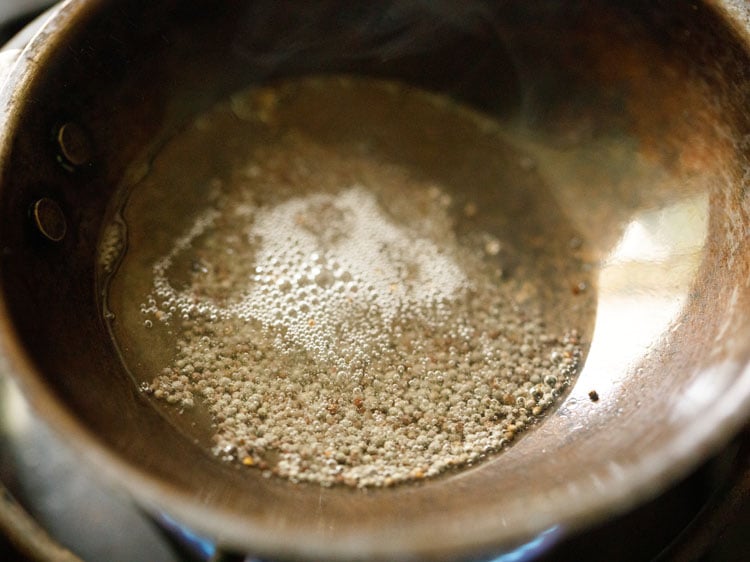
3. Add 10 to 12 curry leaves, 7 to 8 fenugreek seeds (methi seeds) and 2 dry red chilies (broken in half without stems and seeds removed).
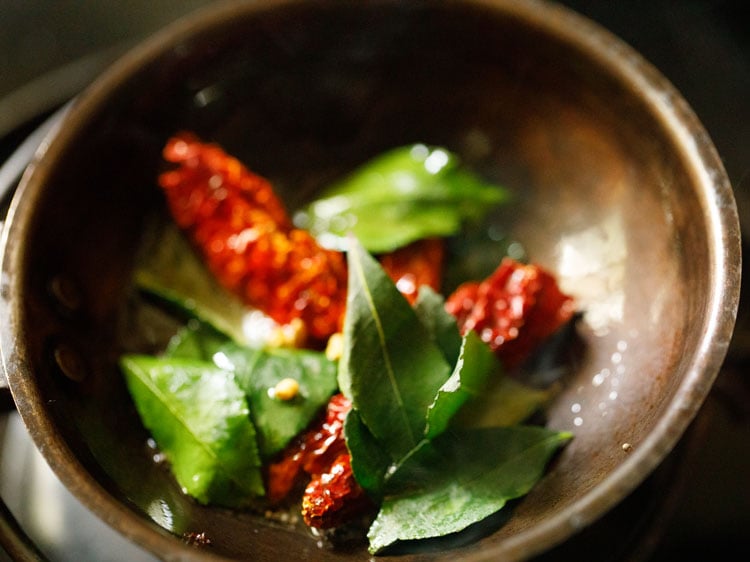
4. Add ¼ cup sliced shallots or pearl onions and ½ teaspoon finely chopped ginger.
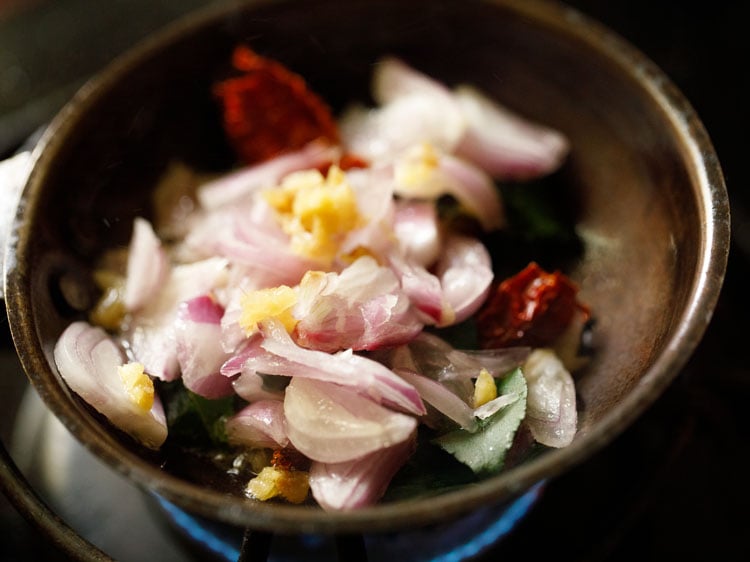
5. Mix and begin to sauté on a low heat.
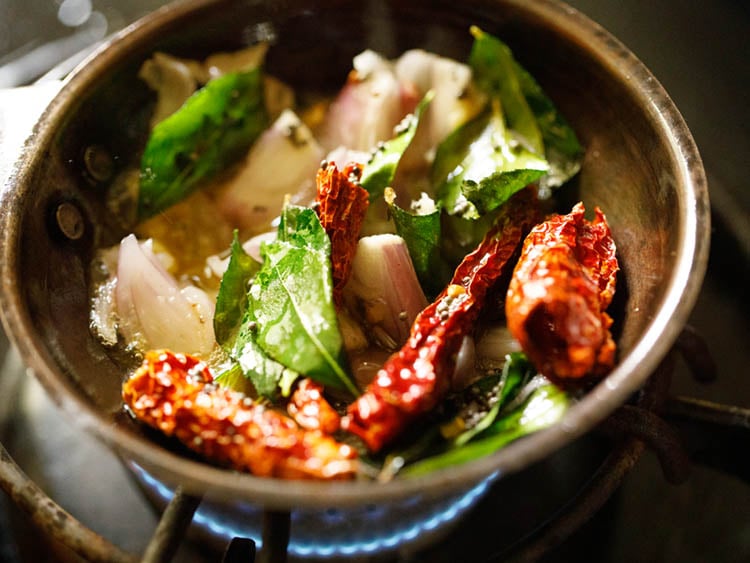
6. Sauté until onions turn light golden or golden.
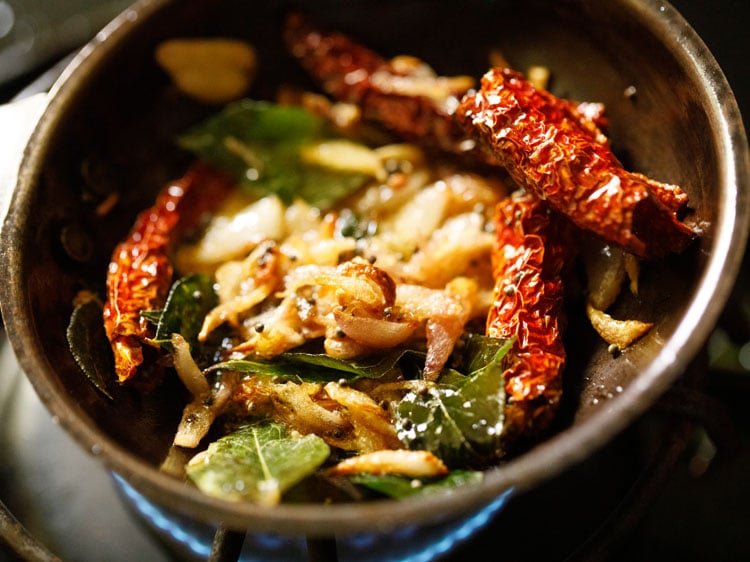
7. Now it is time to move on to step 4, which will assemble these component pieces.
5. Assemble & Make Moru Curry
1. Pour entire tempering mixture in the cooked buttermilk, including the oil.
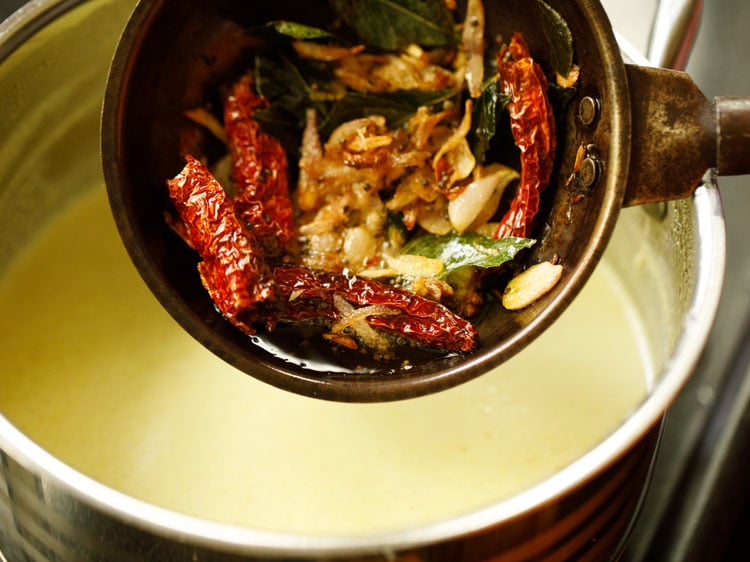
2. Cover and let the flavors infuse for a few minutes.
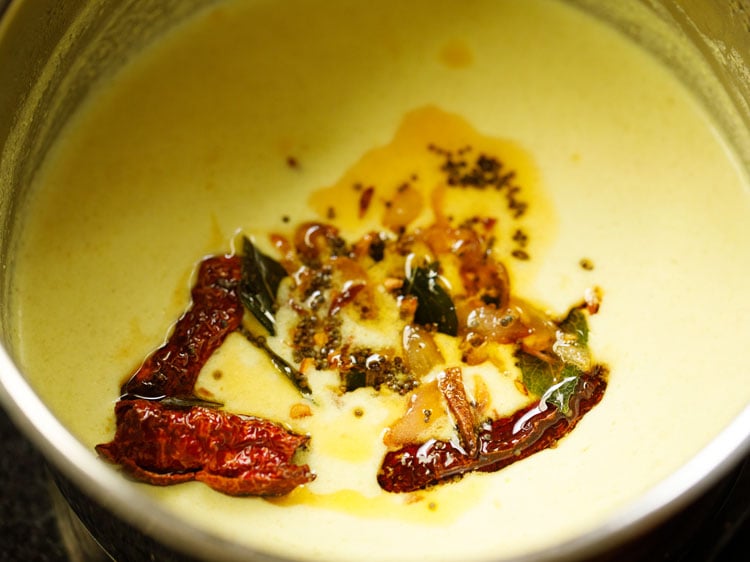
3. Garnish with chopped coriander leaves (optional) and serve moru curry hot or warm with steamed rice.
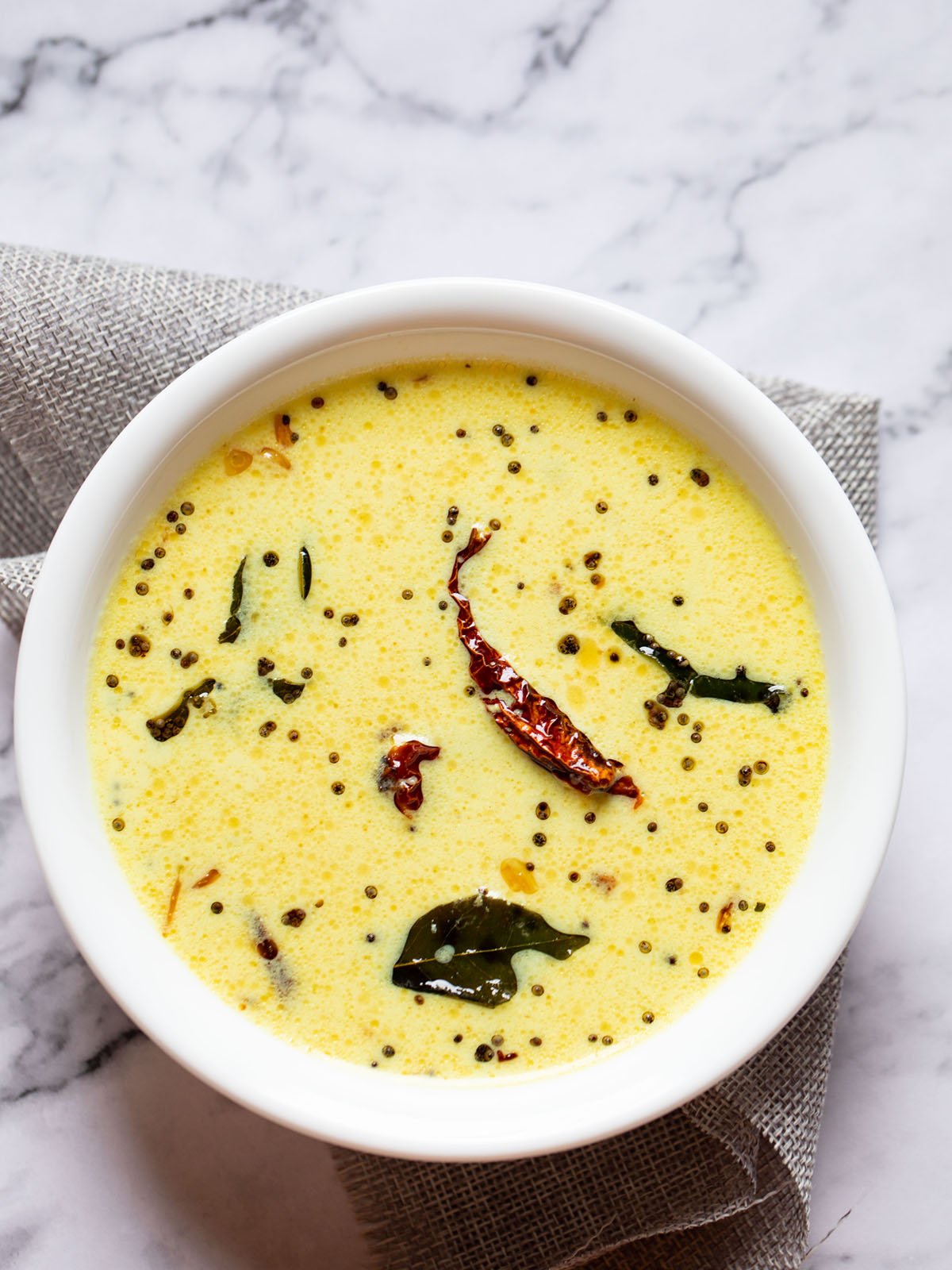
Expert Tips
- Curd: For this recipe, you will require sour curd (yogurt) but not spoiled or rancid. If the curd isn’t sour, then just keep it at room temperature for 2 to 4 hours or until it turns sour.
- Vegetables: You have a choice to add a variety of cooked vegetables in this curry. Choose from as gourd, taro root, yam, Malabar cucumber, summer squash, zucchini, potato, pumpkin, winter squash, belle peppers or leafy greens like drumstick or moringa leaves, spinach, amaranth and kale.
- Coconut: You can even use desiccated coconut in place of fresh grated coconut. This curry can also be made without adding coconut at all.
- Substitutes: Instead of sour curd, you can use sour buttermilk; instead of coconut oil, you can use any other neutral flavored oil or ghee (clarified butter).
- Garnish: You can use chopped coriander leaves to garnish the Moru Curry. If you don’t wish to, you can even skip this step.
- Make ahead: Since this dish is mainly prepared from curd or yogurt, it is best if you consume it fresh and not make it ahead of time or store it further.
FAQs
As Moru Curry is made from curd, I suggest to have it fresh. I would definitely not recommend to make it ahead of time. In Indian food culture and practices, we always give emphasis on having freshly cooked food. Food that is served hot or warm after it is cooked is good for health.
Oftentimes, Moru Curry or pulissery is served over steamed rice and can be garnished with fresh coriander (cilantro) leaves. I also love adding cooked chopped vegetables to mine. Either way, you’re sure to love it.
You can easily substitute your own favorite vegetables in this recipe. Zucchini or summer squash would make a nice substitute for the ash gourd and malabar cucumber, and potato could take the place of the taro. Other vegetables that would work nicely are pumpkins or winter squash, bell peppers or leafy greens like kale or spinach or drumstick leaves.
Certainly. If you do not enjoy the flavor of coconut or are allergic, simply omit making the coconut paste. Gently heat through the buttermilk and then add the fried tempering ingredients. Include half a teaspoon each of chopped green chilies and cumin seeds in the tempering. You can substitute ghee or a neutral oil for the coconut oil during the tempering step.
While this recipe uses curd (yogurt) whisked with water to approximate buttermilk, you can use 2 cups of real buttermilk that is obtained from making butter.
More Kerala Recipes To Try!
Please be sure to rate the recipe in the recipe card or leave a comment below if you have made it. For more vegetarian inspirations, Sign Up for my emails or follow me on Instagram, Youtube, Facebook, Pinterest or Twitter.
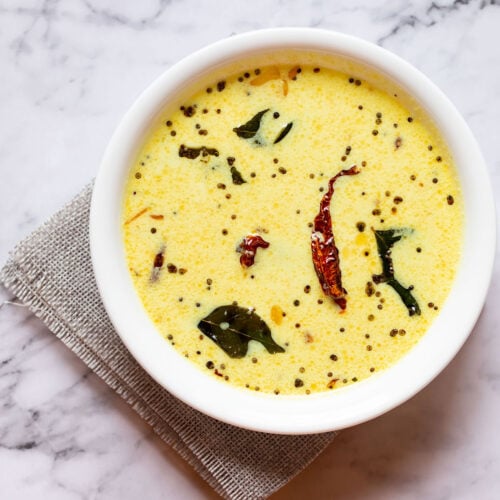
Moru Curry Recipe (Pulissery)
Moru Curry, also known as Pulissery, is a traditional Kerala dish made with whisked curd (yogurt), a smooth coconut paste, and a flavorful tempering of spices & herbs. This mildly spiced and tangy yogurt-based curry is a comforting staple in Kerala cuisine, typically enjoyed with steamed rice. It’s a cherished favorite in our home — a traditional recipe passed down from my mother. Do try this delicious and authentic Pulissery made with love from her kitchen.
Prep Time 10 minutes
Cook Time 15 minutes
Total Time 25 minutes
Prevent your screen from going dark while making the recipe
Making coconut paste
Take grated fresh coconut, chopped green chillies and cumin seeds in a grinder or blender.
Add water and grind to smooth paste. Set aside.
Making curd mixture
In a saucepan or pot, add the sour curd (yogurt), water and turmeric powder.
Whisk to a smooth consistency.
Add salt (as needed) and ground coconut paste.
Mix until well combined.
Simmering
Keep the saucepan or pot with the curd mixture on stovetop on a low heat.
Keep on stirring at intervals.
Let mixture become hot. When you steam coming from the mixture, switch off the heat. Do stir at intervals. Do not boil. Cover and set aside.
Tempering
Heat coconut oil in a small pan. Add mustard seeds and let them crackle.
Add curry leaves, fenugreek seeds and dry red chillies (broken and seeds removed).
Add sliced pearl onions and finely chopped ginger.
Mix and begin to sauté on a low heat.
Sauté until onions turn light golden or golden.
Making moru curry
Pour entire tempering mixture with the oil in the cooked buttermilk.
Cover and let the flavors infuse for a few minutes.
Garnish with chopped coriander leaves (optional) and serve hot or warm with steamed rice.
- Sour curd: Add buttermilk, preferably sour.
- Veggies: Feel free to make moru curry with cooked vegetables. I like yam, taro root, ash gourd and malabar cucumber. You can add greens like spinach, amaranth or drumstick leaves.
- Coconut oil: Coconut oil adds traditional Kerala flavor. The authentic recipe calls for coconut oil, but you can try making moru curry with any neutral tasting oil or use ghee (clarified butter).
- Coconut: Try to use fresh coconut and grind to a fine paste. But if you do not have it, desiccated coconut (unsweetened) can be used. Make sure to soak the desiccated coconut flakes in warm water for 20 minutes before making the paste.
- Skipping Coconut: If you skip adding coconut, then gently heat through the buttermilk and add the fried tempering ingredients. Include half a teaspoon each of cumin seeds and chopped green chillies in the tempering.
- Use sour curd or yogurt for authentic tang.
- Do not boil the curry after adding curd. Always simmer on low heat after adding the curd
- Whisk curd until smooth and lump-free.
- Do not skip on curry leaves.
- Adjust green chilies to your spice preference.
- Don’t skip fenugreek seeds in the tempering – they add a unique depth of flavor.
- You can add ash gourd, cucumber, or ripe mango for a seasonal variation.
Nutrition Facts
Moru Curry Recipe (Pulissery)
Amount Per Serving
Calories 192 Calories from Fat 144
% Daily Value*
Fat 16g25%
Saturated Fat 13g81%
Cholesterol 8mg3%
Sodium 114mg5%
Potassium 197mg6%
Carbohydrates 10g3%
Fiber 3g13%
Sugar 5g6%
Protein 4g8%
Vitamin A 221IU4%
Vitamin B1 (Thiamine) 1mg67%
Vitamin B2 (Riboflavin) 1mg59%
Vitamin B3 (Niacin) 29mg145%
Vitamin B6 1mg50%
Vitamin B12 1µg17%
Vitamin C 54mg65%
Vitamin D 1µg7%
Vitamin E 1mg7%
Vitamin K 1µg1%
Calcium 98mg10%
Vitamin B9 (Folate) 301µg75%
Iron 1mg6%
Magnesium 25mg6%
Phosphorus 93mg9%
Zinc 1mg7%
* Percent Daily Values are based on a 2000 calorie diet.
Moru Curry recipe from the archives was first published on December 2020.

